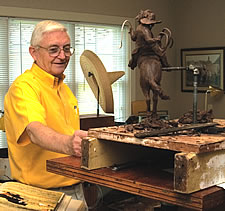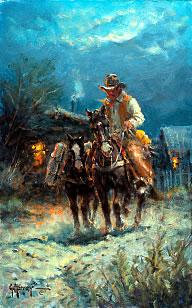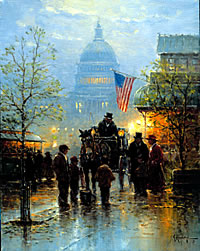 |
|||||||||||||||||

An American Original
|
It sometimes doesn't take a big thing to set the course of a life. For Gerald Harvey Jones ('56), it was simply the thoughtful present his wife gave him when he turned 24. "I had a crew cut and what I did not know could fill a big book," he says with a deep laugh while fondly remembering that fateful day in 1957 when Patty, now his wife of 50 years, decided to get him some paints. "I had always felt this yearning to express myself that way, and I would spend a lot of time in art galleries and museums," says the artist who is best known simply as G. Harvey.
Today, Harvey is a celebrated artist whose work hangs in In 2006, he will open A Tribute to Texas, a significant exhibition at the Bob Bullock Texas State History Museum in Austin that will feature selected paintings and bronzes from the past and some new works. All of which will celebrate what it means to be Texas. The hallmark of a G. Harvey painting is its sense of celebration. "It's just not in me to dwell on the negative aspects of life," Harvey says. "Art, to me, needs to communicate, and what I want to do is evoke a positive emotional connection. "Even when I did a series about the Civil War, I was more interested in depicting the quiet moments, the thoughtful moments, the times when a soldier pauses to think about home." Impressionistic in style and historical in content, his paintings capture the spirit of a memory yet hold the power found in the hope of the future. They depict landscapes, western scenes and city life, and they conjure nostalgic times from the turn of the 20th century. He uses recognizable scenery or symbols to create a sense of place. And in order to ensure authenticity in his work, he does extensive research and visits the places he paints. "It's so important to be there to hear and smell and see the sounds. Then I just try to capture and communicate those feelings." Although he says the point of creation is "very tentative." "It may take a month or two for a piece to really mature in my mind, to get the juices working," he says. "When I'm ready, that's when I don't want anybody to interrupt me until I'm at a point that I know my statement is getting close to what I'm feeling." Teaching — and painting But he says he had no plans to make a living as an artist, even though he always enjoyed expressing himself visually.
"During my first two years of college in Abilene I thought I wanted to be an accountant. But I could never get my projects to balance, so I figured that may not be the best way to go," he says. When he took a class in drafting and the drawing work really felt right to him, he decided to transfer to North Texas. "I didn't take any art classes at North Texas, though, just drafting and engineering in industrial arts. So when Patty gave me my first paints, I painted at night in the living room or the bedroom," he says. At that time, Harvey was teaching industrial arts to ninth graders in Austin. He spent four years on the job and truly enjoyed it. "I had a talented group of students I had doing the assignments I was given as a college student, and we had a lot of success and a lot of fun," he says. But every night he would stay up until midnight or later to paint. With the support and encouragement of his wife and friends, he set up a booth at Laguna Gloria, a large springtime Texas arts festival in Austin. "Between the weather and the crowds, it was an event," he says. "More than once I remember those storm clouds rolling in, and we'd grab the paintings and run for the car. But I sold my first painting there. I got $25 for a 24 x 36 canvas and I thought I was moving." Before long, he sought the opinion of Dewey Bradford, owner of The Country Store gallery in Austin.
"He just tore my paintings all to pieces," Harvey says. "But that's what I needed to be able to move forward, and he told me since I would listen, he would help me. We did it the way it's been done in Europe for more than 150 years. "He gave me paintings from all over the country, and I'd take a magnifying glass to them and study them real close — not for content but for technique. Was it wet on wet, dry brush, overlay or what? I would re-create sections of those paintings and do my own originals. I'd just paint, paint, paint and throw them away." Soon, The Country Store was buying everything he did, and eventually he and Patty decided he should leave teaching and take up art full time. In 1963 his work was exhibited in the Grand National Exhibition in New York and in 1965 he received the New Masters Award from the American Artists Professional League. Quickly, he had galleries in Dallas, Houston, the Panhandle and New York as well as in Austin representing him.
In the mid-1970s, on the advice of a collector, he made the nervy decision to dry up his market and hold a single auction with the works he would create during that year. "It was a very disciplined time for me to focus on the work," he says. "I'd have the paintings in front of me for 6 to 8 months and I could really see which ones didn't match up in quality, and if I couldn't bring them up, I'd destroy them."
Deemed a success, the process was repeated and a second auction was held in Dallas 18 months later at the home of Dallas Cowboys owner Clint Murchison. The next year, Harvey was invited to hold an auction at Burt Reynolds' home in California. "So, the collectors loaded up their jets and we went west," he says. "It was really one of those times when you just pinch yourself and wonder, 'Is this really happening?'" Following more sage advice he decided to return to the galleries, but this time outside of Texas, and for the last 21 years he has been holding exhibitions of new work every other year. Today, his work is exclusively represented at the Whistle Pik Gallery in Fredericksburg and the Legacy Galleries in Jackson, Wyo., and Scottsdale, Ariz. "It's really such a blessing," he says. "There is so much joy in this process of just trying to achieve in reality what I see in my mind's eye. It's sometimes hard to believe I've been able to make a living from it for a lifetime." *All copyrights reserved by G. Harvey Ltd. Paintings photographed by Marc Bennett, White Oak Studio.
|
||||||||||||||||||||||||||||||||||||||||



